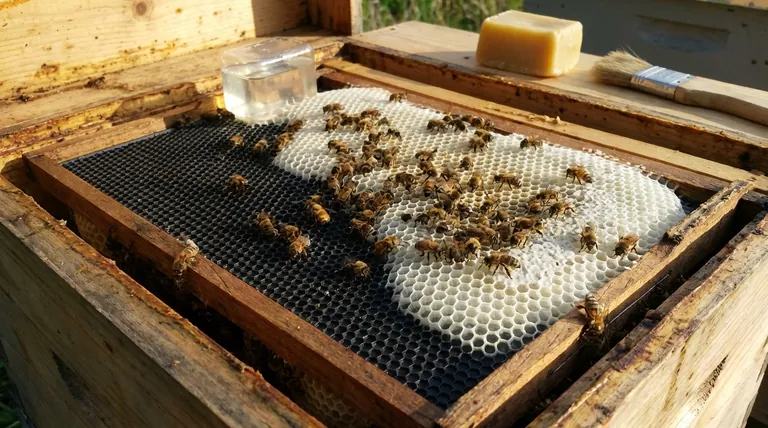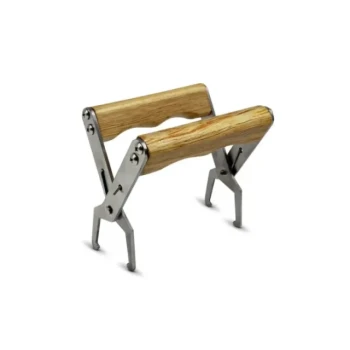To get bees to draw out plastic foundation, you must ensure two conditions are met: the colony has an abundance of nectar (or sugar syrup) to fuel wax production, and the plastic foundation itself is made attractive with a sufficient coating of real beeswax. Without a strong nectar flow, bees lack the resources and motivation to build comb, regardless of the foundation type.
The core challenge isn't forcing bees to accept plastic; it's creating an environment so rich in resources that building new comb becomes their natural and urgent priority. Success depends more on timing, feeding, and colony strength than on the foundation material alone.

The Foundation of Wax Production: Nectar Flow
For bees to "draw out" comb, they must produce beeswax. This is an energy-intensive process fueled entirely by the sugars found in nectar or a substitute.
The Role of Natural Nectar Flow
The single most important factor for comb building is a strong nectar flow. When flowers are blooming and nectar is plentiful, bees are biologically programmed to expand.
This abundance signals to the colony that it's time to create more space for brood and honey storage. With ample resources, they can easily secrete the large quantities of wax needed to build out foundation.
Simulating a Flow with Sugar Syrup
When the natural flow is weak or nonexistent, you must step in. Feeding a sugar syrup (typically a 1:1 ratio of sugar to water) simulates a nectar flow.
This supplementary feeding stimulates the bees' wax glands and gives them the necessary carbohydrates to produce wax and begin building comb. A generous, continuous supply is often required to get them started on plastic.
Optimizing the Plastic Foundation
While nectar flow provides the fuel for building, the foundation itself must be an acceptable surface. Bees can be reluctant to work on bare plastic.
The Importance of a Wax Coating
Most plastic foundations come with a factory-applied layer of beeswax, but this is often thin and insufficient to entice the bees. A thicker, more aromatic coating of real beeswax makes the plastic feel and smell like a natural starting point.
How to Apply Extra Beeswax
You can significantly improve acceptance rates by adding more wax yourself.
Melt pure beeswax in a dedicated skillet or slow cooker. Use a small paint roller to apply a thin, even layer of melted wax to the entire surface of the plastic foundation sheet.
Alternatively, for a faster method, you can carefully dip the plastic frames into a tall container of hot, melted wax. Submerge the frame quickly and pull it out, allowing a thin coat to solidify on the surface.
Understanding the Limitations and Pitfalls
Forcing bees to build is impossible. You must work with their natural instincts and limitations.
Colony Strength Dictates Pace
A strong, populous colony has the workforce needed to draw out multiple frames quickly. A smaller or weaker colony will work much more slowly, potentially only drawing out a single frame or even just a portion of one.
The Critical Influence of Season
Bees have no instinct to expand in the late fall or winter. Their focus shifts to survival and conserving resources. Attempting to get them to draw comb during a dearth or as cold weather approaches is almost always futile.
Strategic Frame Placement
Do not place an entire box of new plastic foundation on a colony at once. Instead, place a single new frame between two fully drawn combs. Bees are inclined to fill in gaps and will be more likely to start working on the new foundation to connect the existing combs.
Making the Right Choice for Your Colony
Your approach should be dictated by the specific conditions of your hive and environment.
- If your primary focus is rapid expansion during a strong honey flow: A light extra coat of wax on the plastic frames may be all that's needed for a strong colony to begin work.
- If your primary focus is building up a colony during a weak nectar flow: You must feed heavy and continuous sugar syrup to simulate a flow and provide the fuel for wax production.
- If your colony is small or it is late in the season: It is best to wait and manage your expectations, as the bees' natural instincts are not aligned with expansion.
Ultimately, you are partnering with the bees by providing the right resources and motivation at the right time.
Summary Table:
| Key Factor | Why It Matters | Actionable Tip |
|---|---|---|
| Nectar Flow | Fuels wax production; bees build when resources are abundant. | Feed 1:1 sugar syrup if a natural flow is weak. |
| Wax Coating | Makes plastic foundation attractive and familiar to bees. | Apply a thin, even layer of melted beeswax to the foundation. |
| Colony Strength | A strong colony has more workers to build comb quickly. | Only introduce new foundation to populous, healthy hives. |
| Season & Timing | Bees are biologically programmed to expand in spring/summer. | Avoid adding foundation late in the season or during a dearth. |
| Frame Placement | Encourages bees to fill gaps and connect existing combs. | Place one new frame between two fully drawn combs. |
Equip Your Apiary for Success with HONESTBEE
Getting bees to draw comb is a fundamental skill for a thriving apiary. Having the right, high-quality supplies is just as critical as proper technique. HONESTBEE is your trusted partner for commercial beekeeping success.
We supply durable, well-designed plastic foundation and a full range of beekeeping equipment to commercial apiaries and distributors through our wholesale-focused operations. Our products are built to support the efficient scaling and management of your operations.
Let's build a more productive future for your bees together.
Contact HONESTBEE today to discuss your wholesale needs and learn how our supplies can help your colonies thrive.
Visual Guide

Related Products
- Food Grade Plastic bee Foundation for Bee Frames
- Beeswax Foundation Sheets Beehive Foundation for Wholesale
- Manual Beeswax Comb Foundation Machine Wax Foundation Mill Embossing Machine
- Professional Frame Preparation: The HONESTBEE Electric Wire Embedder
- HONESTBEE Pneumatic Dual Wire Embedder for W-Pattern Foundation Wiring
People Also Ask
- How to get bees to draw out plastic foundation? Boost Comb Building with Proven Tactics
- What factors should beekeepers consider when choosing between beeswax and plastic foundation? A Guide to Durability vs. Natural Philosophy
- Why do commercial beekeepers prefer plastic foundation? Durable, Reusable, and Cost-Effective
- How does plastic foundation differ from beeswax foundation? Choose the Best for Your Hive's Success
- What is a plastic foundation sheet? A Durable, Reusable Hive Management Solution



















